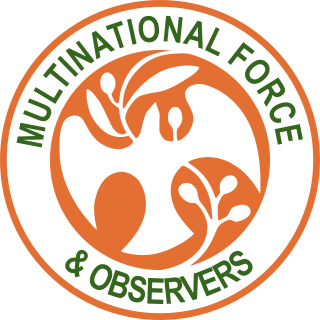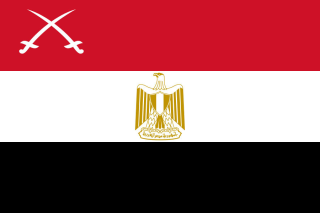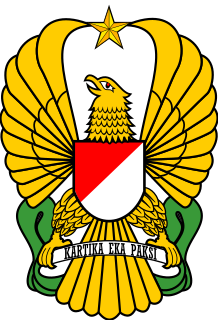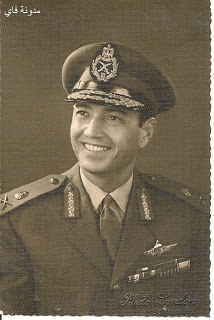
The Six-Day War, also known as the June War, the 1967 Arab–Israeli War or the Third Arab–Israeli War, was an armed conflict fought from 5 to 10 June 1967 between Israel and a coalition of Arab states primarily comprising Jordan, Syria and Egypt.

The Yom Kippur War, also known as the Ramadan War, the October War, the 1973 Arab–Israeli War or the Fourth Arab–Israeli War, was an armed conflict fought from 6 to 25 October 1973 between Israel and a coalition of Arab states led by Egypt and Syria. The majority of combat between the two sides took place in the Sinai Peninsula and the Golan Heights—both of which were occupied by Israel in 1967 — with some fighting in African Egypt and northern Israel. Egypt's initial objective in the war was to seize a foothold on the eastern bank of the Suez Canal and subsequently leverage these gains to negotiate the return of the rest of the Israeli-occupied Sinai Peninsula.

The United Nations Truce Supervision Organization (UNTSO) is an organization founded on 29 May 1948 for peacekeeping in the Middle East. Established amidst the 1948 Arab–Israeli War, its primary task was initially to provide the military command structure to the peacekeeping forces in the Middle East to enable the peacekeepers to observe and maintain the ceasefire, and in assisting the parties to the Armistice Agreements in the supervision of the application and observance of the terms of those Agreements. The organization's structure and role has evolved over time as a result of the various conflicts in the region and at times UNTSO personnel have been used to rapidly deploy to other areas of the Middle East in support of other United Nations operations. The command structure of the UNTSO was maintained to cover the later peacekeeping organisations of the United Nations Disengagement Observer Force (UNDOF) and the United Nations Interim Force in Lebanon (UNIFIL) to which UNTSO continues to provide military observers.
The history of the Israel Defense Forces (IDF) intertwines in its early stages with history of the Haganah.

The Irish Army, known simply as the Army, is the land component of the Defence Forces of Ireland. Approximately 7,300 people served in the Irish Army on a permanent basis as of May 2016, and there were 1,600 active reservists, divided into two geographically organised brigades. As well as maintaining its primary roles of defending the State and internal security within the State, since 1958 the Army has had a continuous presence in peacekeeping missions around the world. The Army also participates in the European Union Battlegroups. The Air Corps and Naval Service support the Army in carrying out its roles.

Operation Badr or Plan Badr was the code name for the Egyptian military operation to cross the Suez Canal and seize the Bar Lev Line of Israeli fortifications on October 6, 1973. Launched in conjunction with a Syrian assault on the Golan Heights, this attack marked the start of the Yom Kippur War.

The Multinational Force and Observers (MFO) is an international peacekeeping force overseeing the terms of the peace treaty between Egypt and Israel. The MFO generally operates in and around the Sinai peninsula.

The Egyptian Army or Egyptian Ground Forces is the land warfare branch of the Egyptian Armed Forces. It is the largest service branch of the Egyptian Armed Forces.

The Indonesian Army is the land branch of the Indonesian National Armed Forces. It has an estimated strength of 300,000 active personnel. The history of the Indonesian Army has its roots in 1945 when the Tentara Keamanan Rakyat (TKR) "Civil Security Forces" first emerged as a paramilitary and police corps.

The first United Nations Emergency Force (UNEF) was established by the United Nations General Assembly to secure an end to the Suez Crisis with resolution 1001 (ES-I) on 7 November 1956. The force was developed in large measure as a result of efforts by UN Secretary-General Dag Hammarskjöld and a proposal and effort from Canadian Minister of External Affairs Lester B. Pearson, who would later win the Nobel Peace Prize for it. The General Assembly had approved a plan submitted by the Secretary-General which envisaged the deployment of UNEF on both sides of the armistice line; Egypt accepted receiving the UN forces, but Israel refused it. The first UNEF lasted until 1967. The UN General Assembly later established a Second United Nations Emergency Force in 1973 in response to the Yom Kippur War. UNEF II lasted until 1979.

Saad El Din Mohamed el-Husseiny el-Shazly was an Egyptian military commander. He was Egypt's chief of staff during the October War. Following his public criticism of the Camp David Accords, he was dismissed from his post as Ambassador to Britain and Portugal and went to Algeria as a political refugee.

The Army Strategic Reserves Command is a combined-arms formation of the Indonesian Army. Kostrad is a Corps level command which has up to 35,000 troops. It also supervises operational readiness among all commands and conducts defence and security operations at the strategic level in accordance with policies under the command of the commander of the Indonesian National Armed Forces. In contrast to its name ("Reserves"), Kostrad is the main warfare combat unit of the Indonesian Army. While Kopassus is the elite-special forces of the Indonesian Army, Kostrad as "Komando Utama Operasi" or "Principal Operational Command" still maintains as the first-line combat formation of the Indonesian National Armed Forces along with the Kopassus. This corps has three divisions which are:

The United Nations Disengagement Observer Force (UNDOF) is a United Nations peacekeeping mission tasked with maintaining the ceasefire between Israel and Syria in the aftermath of the 1973 Yom Kippur War. The mission was established by United Nations Security Council Resolution 350 on 31 May 1974, to implement Resolution 338 (1973) which called for an immediate ceasefire and implementation of United Nations Security Council Resolution 242.

The United Nations Transition Assistance Group (UNTAG) was a United Nations (UN) peacekeeping force deployed from April 1989 to March 1990 in Namibia to monitor the peace process and elections there. Namibia had been occupied by South Africa since 1915, first under a League of Nations mandate and later illegally. Since 1966, South African forces had been combating an insurgency by the People's Liberation Army of Namibia (PLAN), the military wing of the Namibian-nationalist South West African People's Organization (SWAPO). The UN Security Council passed Resolution 435 in 1978, which set out a plan for elections administered by South Africa but under UN supervision and control after a ceasefire. However, only in 1988 were the two parties able to agree to a ceasefire. As UNTAG began to deploy peacekeepers, military observers, police, and political workers, hostilities were briefly renewed on the day the transition process was supposed to begin. After a new round of negotiations, a second date was set and the elections process began in earnest. Elections for the constitutional assembly took place in November 1989. They were peaceful and declared free and fair; SWAPO won a majority of the seats. The new constitution was adopted four months later and it was followed by Namibia's official independence and the successful conclusion of UNTAG.
The United Nations Peacekeeping efforts began in 1948. Its first activity was in the Middle East to observe and maintain the ceasefire during the 1948 Arab–Israeli War. Since then, United Nations peacekeepers have taken part in a total of 72 missions around the globe, 14 of which continue today. The peacekeeping force as a whole received the Nobel Peace Prize in 1988.

The Battle of Ismailia took place between the Egyptian Army and the Israeli Defense Forces (IDF) during the last stages of the Yom Kippur War during October 18–22, 1973, south of the city of Ismailia, on the west bank of the Suez Canal in Egypt. The battle itself took place as part of the larger IDF-launched Operation Abiray-Lev, in an attempt to seize Ismailia and thereby sever the logistical and supply lines of most of Egypt's Second Field Army across the Suez Canal.

So far India has taken part in 49 Peacekeeping missions with a total contribution exceeding 200,000 troops and a significant number of police personnel having been deployed. In 2014 India is the third largest troop contributor country [TCC] with 7,860 personnel deployed with ten UN Peacekeeping Missions of which 995 are police personnel, including the first Female Formed Police Unit under the UN. Recently Indian Peacekeepers were lauded by the UN for their efforts in preventing a carnage in the South Sudan conflict which resulted in the death of two of its soldiers.

This article deals with the history and development of tanks of the Israeli Army, from their first use after World War II in the establishment of the State of Israel after the end of the British Mandate, and into the Cold War and what today is considered the modern era.

Major General Bengt (T:son) Trygvesson Liljestrand was a Swedish Army officer. He served as Chief of Staff of the United Nations Truce Supervision Organization (UNTSO) from 1974 to 1975 and Force Commander of the Second United Nations Emergency Force from 1975 to 1976.
















